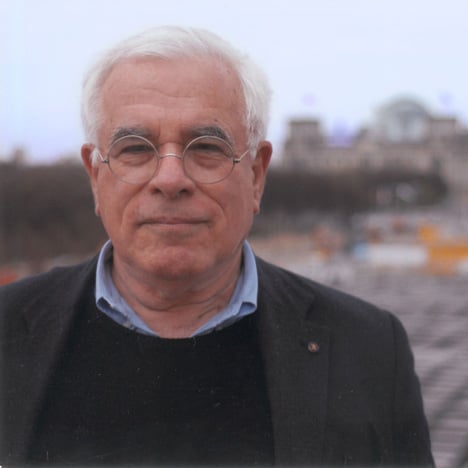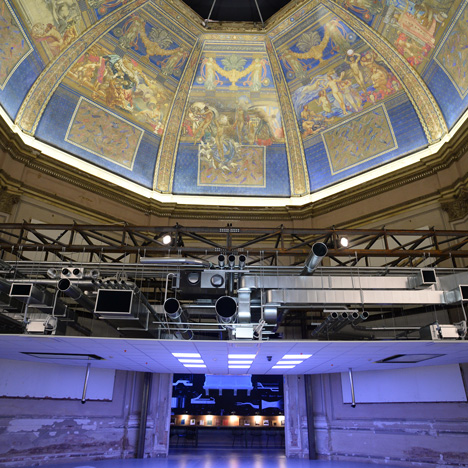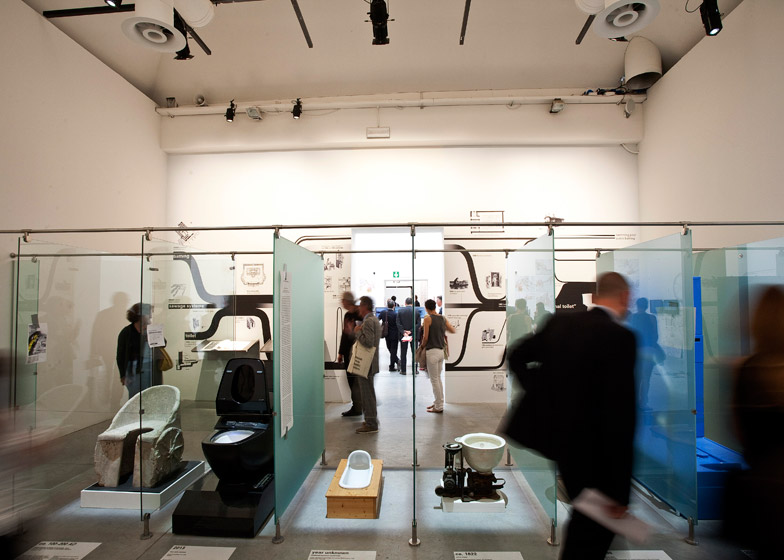
Rem Koolhaas is stating "the end" of his career, says Peter Eisenman
Venice Architecture Biennale 2014: curator Rem Koolhaas has used the biennale to announce the end of his "hegemony" over the profession, according to architect Peter Eisenman (+ interview).
"He's stating his end," said Eisenman, adding: "Rem Koolhaas presents the Biennale as la fine [the end]: 'The end of my career, the end of my hegemony, the end of my mythology, the end of everything, the end of architecture'."
The 81-year old American architect, who helped the Dutch architect at the start of his career, said that Koolhaas, 70, was "the totemic figure" of the last 50 years and compared him to Le Corbusier's dominance of the first half of the twentieth century.
"I think it's very important to have lived in the time of Rem, like to have lived in the time of Corbusier," said Eisenman, recalling the day he turned up outside Le Corbusier's Paris atelier in 1962 but felt too intimidated to ring the doorbell: "I think that students today feel the same way about the mythology of Koolhaas."
Called Fundamentals, the biennale opened to the public on the weekend and includes a central exhibition called Elements, which focuses on parts of buildings such as stairs, escalators and toilets rather than buildings.

Eisenman said the Elements show was like language without grammar: "Any language is grammar," he said. "So, if architecture is to be considered a language, 'elements' don't matter. So for me what's missing [from the show], purposely missing, is the grammatic."
Koolhaas "doesn't believe in grammar," he added.
Giving a tour of the show last week, Koolhaas said he hoped Elements would lead to "a modernisation of the core of architecture and architectural thinking itself."
Eisenman, head of Eisenman Architects, has known Koolhaas since the 70s, when the Dutch architect studied at Eisenman's Institute for Architecture and Urban Studies (IAUS) in New York.
"I helped publish his first book," said Eisenman. "I got the money to publish Delirious New York, I was on the jury that gave him the first prize he ever won for his architecture. I gave him an office where to write Delirious New York, so I know Rem from the beginning."
Eisenman made the comments in Venice on Friday, where he was attending the opening of an exhibition about the Yenikapi Project, a vast new development in Istanbul he designed in collaboration with Aytaç Architects.

See all our stories about the Venice Architecture Biennale 2014 »
Portrait of Peter Eisenman is courtesy of Vanderbilt University.
Here's a transcript of the interview:
Valentina Ciuffi: Let's talk about Elements [the exhibition occupying the Central Pavilion at the Venice Architecture Biennale]. You've known Rem from the very beginning – what do you think of the core show at his biennale?
Peter Eisenman: First of all, any language is grammar. The thing that changes from Italian to English is not the words being different, but grammar. So, if architecture is to be considered a language, 'elements' don't matter. I mean, whatever the words are, they're all the same. So for me what's missing [from the show], purposely missing, is the grammatic.
Look, 50 years ago, we knew that Modernism was dead. Le Corbusier, Mies van der Rohe, Frank Lloyd Wright: all dead. We didn't know what the future was but we knew all this was dead.
In '68 we found out what the future was going to be: the revolution in '68 in the schools, in culture, in art etc: all was changed. We are now 50 years from '64 and the totemic figure of these 50 years, the symbolic figure? Rem Koolhaas, right?
Rem Koolhaas presents the Biennale as la fine [the end]: "The end of my career, the end of my hegemony, the end of my mythology, the end of everything, the end of architecture." Because we don't have architects [in the biennale]. We have performance, we have film, we have video; we have everything but architecture.
So Rem is saying: "You know, I want to say: I don't do this, I don't do this, I don't do this, but I also want to tell you that I don't want you to tell me my end. I'm telling you the end." He makes the point, bonk, like that.
Valentina Ciuffi: He's stating his end?
Peter Eisenman: He's stating his end. And he's finished. And we don't know what's coming in four five years. 2018, like 1968, could be a revolution. Who knows?
Valentina Ciuffi: So this end is the start of something new?
Peter Eisenman: Always. History always goes like this.
Valentina Ciuffi: But when he says no to archistars, yes to architecture…
Peter Eisenman: He is the archistar! He is the origin of the archistar. He was there at the beginning.
Valentina Ciuffi: You taught all the archistars. They all came from your academy [the Institute for Architecture and Urban Studies in New York].
Peter Eisenman: He is the archistar and now he is the curator star. He's killed all the archistars, and now he is going [to be the] single curator star.
Valentina Ciuffi: You are one of the few people able to be so straight with him because…
Peter Eisenman: I know him very well. We started together way back. I helped publish his first book. I got the money to publish Delirious New York, I was on the jury that gave him the first prize he ever won for his architecture. I gave him an office where to write Delirious New York, so I know Rem from the beginning.
Valentina Ciuffi: So you think this idea of taking elements and not thinking about the grammar is totally…
Peter Eisenman: Well it's Rem. It's Rem because he doesn't believe in grammar. That's Rem, and that's good. Look, when he was at the Architecture Association School in 1972, in the spring of '72 when he quit – because he never finish school, you have to understand – because he went to the new director and he said, quote: "I want to learn fundamentals. Where can I learn fundamentals?"
And the director looked at him and said: "We don't teach fundamentals here. We teach language." And then he quit. So there is a relationship between quitting the school in 1972 and Fundamentals today. Okay?
Valentina Ciuffi: You are perhaps one of the the few people who can be so direct about Rem.
Peter Eisenman: I love Rem. I think it's very important to have lived in the time of Rem, like to have lived in the time of Corbusier. In '62 I went to Paris and I stood on the doorstep of Le Corbusier's atelier at 35 rue de Sèvres with my mentor Colin Rowe. He said, "Ring the doorbell!" And I said: "What I'm going to say to this guy? What am I doing here?"
And I think that students today feel the same way about the mythology of Koolhaas: "What am I going to say to him?" So very few people would challenge him. If you ask him questions; yesterday at the press conference people were asking him questions and he said: "I don't answer questions like this. You should stop asking questions."
So he's a very, very clear and a good person to put this biennale on. And sarà la fine dell'architecttura [it will be the end of architecture].